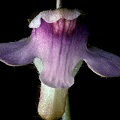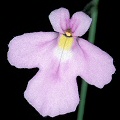Growing Terrestrial Genlisea
(Carnivorous Plant Newsletter, 1994, 23:2, 36.)
Late in the summer of 1991 I received in trade a plastic bag
filled with live Sphagnum. Carefully exploring through
the strands I was thrilled to discover that the object of my desire
had survived the shipping ordeal, and I finally had an opportunity to grow a
Genlisea.
My new acquisition was smaller than a grain of rice, so I planted it
immediately.
Some species of Genlisea are aquatics and others are
terrestrials. I wasn't sure of my new plant's preferred habit,
so to be safe I embedded it in
a loose mix of live fluffy Sphagnum just a few cm above the water table.
The plant is now thriving and has taught me many things about
growing species from this genus.
Despite its reputatation as a difficult plant, my first species
(Genlisea hispidula) is very accomodating. I grow mine in
live or unmilled dead Sphagnum. A more densely packed
medium (such as a peat or sand mix) may not allow tiny aquatic creatures to
swim into the traps. I keep the water table near or just below the
moss surface. Of course, use only pure water for these plants. I grow mine
under 50% shade cloth.
The spatulate or cuneiform leaves (up to three cm long each) are
arranged in a rosette. The plant sometimes becomes covered by
heads of growing Sphagnum. When this happens I pull the strands
back to keep the plant
from becoming buried. Kept at about 18-35°C
(65-95°F) the
plant will grow quickly. Cooler than this and its growth slows. I suspect
a frost, however light, would be the end of your Genlisea. Fertilizer
is not necessary so I have never used it.
When the rosette matured it produced an unbranched scape 20
cm tall with several flowers (Figure 1). As I examined the
flowers something kept nagging me--I felt they reminded
me of something but it wasn't until I was composing
this article that I realized what it was. The arching lid-like upper corolla
lip, the strange lower lip, and the sub-conical spur conspire
to mimic the lid, peristome, and basin of a Cephalotus pitcher (But I am
not suggesting the flower is carnivorous!).
Carefully following Peter Taylor's
key in CPN 20:1, p22, I was easily able to identify
the plant as G. hispidula.
I was slightly surprised the plant was correctly identified when it was
sent to me--a
real rarity with the related genus Utricularia!
 The carnivorous traps on this genus are produced below ground
from the rosette base
and are shaped like an inverted "Y" a few to several centimeters in
total length. Excellent line drawings of
the traps can be found in Lloyd or Slack's first book.
Midway between the trap's point of
attachment and the bifurcation is a tumerous swelling--the utricle.
This digestion chamber is the
ultimate destination for wayward rotifers. A tube connects the utricle to the
trap bifurcation.
Each of the two branches of the
trap is tightly twisted into a helix. A slit spiralling
along the length of the helix allows free-swimming organisms into the
twisted canal.
Once inside, the creatures are constrained to swim along the inside of
the canal by that old standbye in plant carnivory (and something I
feel I have read countless times), inward pointing hairs. These hairs
allow the creatures to swim only towards the trap's utricle. Occasional
columnar structures called prop-cells connect the walls of the canal
and keep them spaced at a fixed, optimal separation.
There are
many unanswered questions regarding the function of the traps. After
this article I present
an order of magnitude calculation
to explore if Genlisea suck water through their
traps in order to accentuate their efficiency. But
despite our poor understanding
of the mechanics of the Genlisea traps they are effective. The utricle
of older traps are clearly discolored by the internal accumulation of
digested material and detritus.
The carnivorous traps on this genus are produced below ground
from the rosette base
and are shaped like an inverted "Y" a few to several centimeters in
total length. Excellent line drawings of
the traps can be found in Lloyd or Slack's first book.
Midway between the trap's point of
attachment and the bifurcation is a tumerous swelling--the utricle.
This digestion chamber is the
ultimate destination for wayward rotifers. A tube connects the utricle to the
trap bifurcation.
Each of the two branches of the
trap is tightly twisted into a helix. A slit spiralling
along the length of the helix allows free-swimming organisms into the
twisted canal.
Once inside, the creatures are constrained to swim along the inside of
the canal by that old standbye in plant carnivory (and something I
feel I have read countless times), inward pointing hairs. These hairs
allow the creatures to swim only towards the trap's utricle. Occasional
columnar structures called prop-cells connect the walls of the canal
and keep them spaced at a fixed, optimal separation.
There are
many unanswered questions regarding the function of the traps. After
this article I present
an order of magnitude calculation
to explore if Genlisea suck water through their
traps in order to accentuate their efficiency. But
despite our poor understanding
of the mechanics of the Genlisea traps they are effective. The utricle
of older traps are clearly discolored by the internal accumulation of
digested material and detritus.
A more recent addition to my CP collection is
G. violacea. This plant is smaller in all respects than
G. hispidula, with petiolate elliptical leaves 2 cm in total
length. In flower it is much different, and resembles from the front a
small Viola flower. The flowers are spaced only a few
centimeters apart, and are long-lived enough so that several
flowers are in full bloom in a lovely spray at all times.
It grows well using the same culture
as for G. hispidula.
 These species, especially G. hispidula,
are easy to propagate. For vegetative propagation use
cuttings from leaves or traps. Some even report success
using scapes!
The cuttings should be partially buried in live
Sphagnum.
For leaf cuttings, remove as much of the petiole base as possible, and
anticipate the new plantlets to develop anywhere on the leaf. Leaves can
be cut into pieces for more plantlets.
If scape cuttings actually work, I expect the new plants would
develop from the peduncle scales.
This species will produce viable seed even if not selfed. When
the seed capsule matures and splits (see Taylor's figure 1-5, CPN 20:1,
p34, for the remarkable details of capsule dehiscence), sprinkle the seed
immmediately on wet Sphagnum. Germination will occur in a
few weeks. Treat cuttings and seed as you would mature plants.
The species G. violacea is a little more challenging.
Selfings don't produce seed, and leaf cuttings have never struck.
I owe a thanks to
Gordon Snelling who first told me about the success of trap cuttings.
In fact when I have examined the traps still attached to a plant I
have noticed parts of the traps (especially the
tips) may develop adventitious leaves which grow to the soil surface and
produce new plants.
These species, especially G. hispidula,
are easy to propagate. For vegetative propagation use
cuttings from leaves or traps. Some even report success
using scapes!
The cuttings should be partially buried in live
Sphagnum.
For leaf cuttings, remove as much of the petiole base as possible, and
anticipate the new plantlets to develop anywhere on the leaf. Leaves can
be cut into pieces for more plantlets.
If scape cuttings actually work, I expect the new plants would
develop from the peduncle scales.
This species will produce viable seed even if not selfed. When
the seed capsule matures and splits (see Taylor's figure 1-5, CPN 20:1,
p34, for the remarkable details of capsule dehiscence), sprinkle the seed
immmediately on wet Sphagnum. Germination will occur in a
few weeks. Treat cuttings and seed as you would mature plants.
The species G. violacea is a little more challenging.
Selfings don't produce seed, and leaf cuttings have never struck.
I owe a thanks to
Gordon Snelling who first told me about the success of trap cuttings.
In fact when I have examined the traps still attached to a plant I
have noticed parts of the traps (especially the
tips) may develop adventitious leaves which grow to the soil surface and
produce new plants.
I hope I have whetted your appetite
for these remarkable little plants. In attention to detail
their traps are the most complex
of all the carnivorous plants--second perhaps
only to Utricularia. Their flowers are delightful, and when the species
discussed here reach flowering size they continually produce scapes all
year.
And the plants are easy! If you can grow terrestrial Utricularia
then you can grow the plants I described here.
I have never grown an aquatic Genlisea,
and anticipate they may be more exacting in their treatment (as is the case
with most aquatic Utricularia). Very recently I have obtained
specimens of G. repens and a plant which may be G. pygmaea.
Time will tell how much luck I have with them. Good luck with yours!
Postscript: Both G. repens and G. pygmaea have
acclimated well to greenhouse culture, and can be grown as
G. hispidula. Both are very small plants, however, and multiply very
slowly.